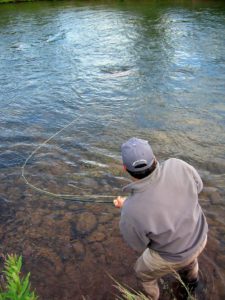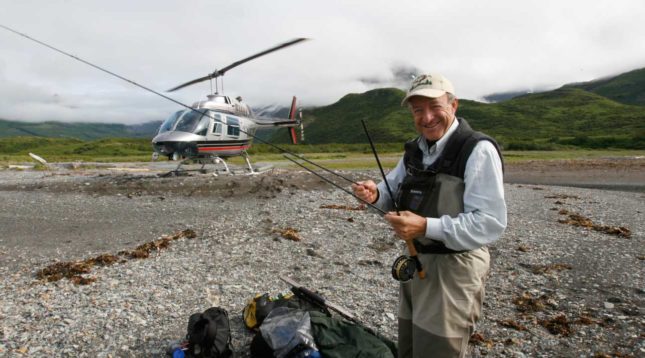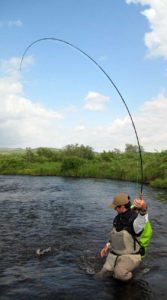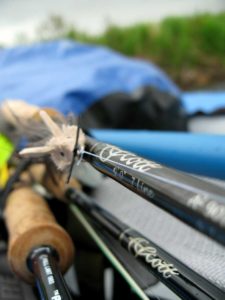Epic Blog
Machete’s Guide Gear Talk – OUTPOST Fly Rods
06.14.20
Welcome back folks! In the last segment of Machete’s Guide Gear Talk we talked about some considerations to make regarding what clothing articles to bring along for both guides and clients who are planning to spend time with us at either of our remote fly fishing trips. Now let’s shift gears and focus on fly fishing equipment. If I’ve learned anything after spending my last three summers guiding in Alaska it’s this: Good equipment matters. Whether that’s a fly rod, or a reel, a backpack or a pair of waders, you will quickly find out just how much the difference between having the right tool or the wrong tool will effect your experience on the Alaska Peninsula.
This article will dive into some of the different fly rod options to consider for our first camp, OUTPOST.
The Playing Field
The first thing to consider are the extreme environmental factors that you subject your gear to on a daily basis. As a client, you will demand more of your equipment in one week’s worth of fishing than most people do in a lifetime of use. As a guide, you’re going to tax your gear to the absolute limit of what it can tolerate. Having quality made items is essential. Luckily, that doesn’t always equate to buying the most expensive gear.
Decision Time
These days there’s an entire universe of fly rod companies to choose from when considering a new stick for your week long adventure. As an outfitter, EPIC offers a wide selection of rods to help fill in the gaps in a client’s arsenal and to cover the niche weights that most anglers simply do not need to consider for their home-waters. How many trout fanatics out there have a 10 wt sitting in their closet? While we can, to some extent, accommodate individuals who have none of their own fly fishing tackle, on average most of our clients show up at camp with at least two rods. One heavyweight rod and one lightweight rod.
The wide diversity of fish species we target here is what makes this venue so unique, but it also creates a conundrum for the prospective angler: which rods to bring? The official recommendations are a 5 wt, 7 wt and 9 wt. This represents the divergence between targeting smaller species like grayling and rainbow trout and hunting larger species like king salmon and chum salmon. While you would want anything from a 4-6 wt for the former, anything below a 7 wt for the latter is likely to end up in a few extra pieces for the return voyage home.
Now there’s a choice to be made, and it’s a hard one. Do you want to be a generalist or a specialist? Put another way, do you want one rod weight to rule them all, or do you want to bring a series of rods that will be more species specific?
The Generalist
Both choices have advantages and drawbacks. First let’s consider bringing one rod for a week of fishing at our OUTPOST camp. Here an angler can experience everything from perfecting their dead drifted dry fly technique for eager grayling rising to emerging caddis, to hucking large, gaudy streamers at king salmon that push the twenty pound threshold. In between are pockets of veracious mice eating trout that can easily break 12 lb mono and silver sided sea run dollies that smash and grab streamers like it’s going out of style. One rod, but which one?
My answer is the 7 wt. Except for the largest king salmon, it’s enough gun to put the screws to most of the salmon we encounter while not being too much stick to damper the electrifying acrobatics of a hot trout or the erratic head shaking of a pissed off Dolly Varden. The drawback? It’s too heavy to make much sport out of targeting arctic grayling, especially with a dry fly.
The Specialist
Let’s consider the other option. A rod best suited to fishing specifically for trout, grayling and Dolly Varden. Here we have a coin toss between two rod weights, a 5 and 6 wt. While the 5 wt is the superior light line rod for fishing dries and smaller patterns to eager trout and grayling, I personally think the 6 wt is king. While this does run contrary to the recommended 5 wt, it offers some unique advantages. It packs a heavier punch than the 5 wt, and if you’ve ever tried to launch a streamer to the far bank with half a rabbit flank twisted around a weighted metal shank you’ll quickly realize why a 6 wt is the optimal rod for the job. The major drawback is it’s on the heavy side for grayling and some of the mid-sized rainbows, but it’s a perfect fit for the bigger bows and Dolly Varden that commonly push well past 20 inches and fight with a veracity that forever endears them to the anglers that have made their acquaintance.
So we have a few options to consider for our lightweight rod, but what about our big stick? I think the best all around choice would be a 9 wt. You will encounter some seriously big fish with this stick in hand. There are chums that push 12+ pounds and fight with a stubborn brutishness that places them several weights above their class. Yes, an 8 or 7 wt will handle most chums just fine. But then there are the kings…

A stiff 9 wt, or a 10 wt, can apply a lot of pressure on large king salmon for shorter fighting times.
Some of the larger specimens landed are easily in the 20 pound class range. Maybe a few tipping the scales on the high end of that range. A trophy buck’s massive head alone can weigh as much as your house cat. But here’s the catch, where we often find them they’re boxed in, confined by the small scale of our home creek. In a big river with powerful hydraulics, like the one that meets our creek at its confluence, a 9 wt rod might quickly find itself outgunned (but in the smaller arena it provides the necessary backbone to wear out a big fish and ultimately turn them). If you wanted to exclusively target kings there’s nothing wrong with a 10 wt. One of the biggest advantages to matching the rod weight to the fish is it gives you the ability to fight a fish fast and end the fight without playing a fish out to the point of exhaustion.
So Many Good Choices
When selecting a rod brand there are more good options available on the market than ever. And today, lucky for us contemporary anglers, we have a better selection of high modulus graphite rods to choose from than at anytime in the past. I won’t get into the weeds about which brands I think are superior to others, but I will say that you would do far better to buy a name brand rod from a reputable house that specializes in manufacturing fly rods compared to buying mass-produced rods or an off-brand. If you’re looking for top shelf you can’t go wrong with companies like Sage, Winston, or Scott. If you’re on a budget consider Echo, Redington, TFO, or Orvis
Stay Tuned
Check back in for a future in depth discussion about what rod and tackle considerations to make for our second remote wilderness camp, Alaska Wilderness SAFARI!
And stay tuned for the next installment of Machete’s Guide Gear Talk, where we’ll talk about fly reels. Until next time!
Click here for another blog on fly rods for our remote fly fishing trips.
Find more Machete articles here.





